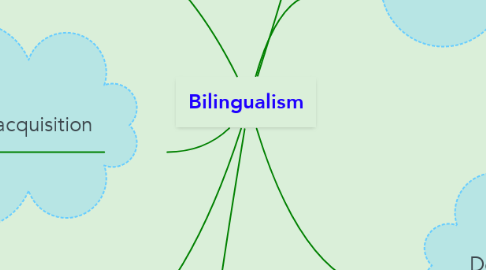Bilingualism
by Dony Ramos

1. Individual Bilingualism
1.1. The ability of an individual to acquire and use a second language fluently by his/her own
2. Societal Bilingualism
2.1. It refers about the adquisition of two or more languages which are spoken in a given society.
3. Age of acquisition
3.1. It's a variable concerning to the age at which a language is typically learned
4. Social orientation
4.1. It's about the social context in which an individual is located in order to learn a new language
5. Primary context / Natural Bilingualism
5.1. The unconscious process in which an individual, in this case a child is able to acquire both languages naturally without being instructed.
6. Secondary context / School Bilingualism
6.1. It's a conscious process in which childs learn both languages through instruction given in a school.
7. Elective Bilinguals
7.1. It's the acquisition of a second language by choice in which an individual usually learns the new language by enrolling in pertinent classes and choosing to be immersed in a society which primarily uses the language which is being learned.
8. Childs
9. Adults
10. Subtractive Bilingualism
10.1. The social context may be based on speaking a single language without using the native language of the speaker; as a consequence, the second language is more used than the first.
11. Additive Bilingualism
11.1. The social environment allows the use of both languages (first and second).
12. Degree of bilingualism
13. Context of bilingual language acquisition
14. Domain of use of each language
14.1. It's refering to the use of both languages according to different social environments.
15. Balanced Bilinguals
15.1. They have a high domain of two languages at the point to be considered a Native Speaker in both.
16. Dominant Bilinguals
16.1. Certain people who better skills and understanding in just one o the two languages that have been learned.
17. Passive / Recessive Bilinguals
17.1. It's when the speaker of a certain language has been exposed to another language in childhood and suddently gets a native-like comprehension of it forgetting a little bit how to speak his/her first language.
18. Semilinguals / Limited Bilinguals
18.1. It refers to individuals who have not mastered totally any of two languages.
19. Naturalistic fused setting
19.1. This usually happens to inmigrant childs that are exposed to both languages in the same context
20. Naturalistic separate setting
20.1. It's when the child acquires both languages due to his parents speak different languages.
21. Circumstantial Bilinguals
21.1. It's related to learning a second language because it is a need into the country the speaker lives.
22. -Size of vocabulary -Correctness of language -Language creation -Mastery of the functions of language (e.g., emotive, cognitive) -Meanings and imagery
23. • Family • Friendship • Religion • Education • Employment


